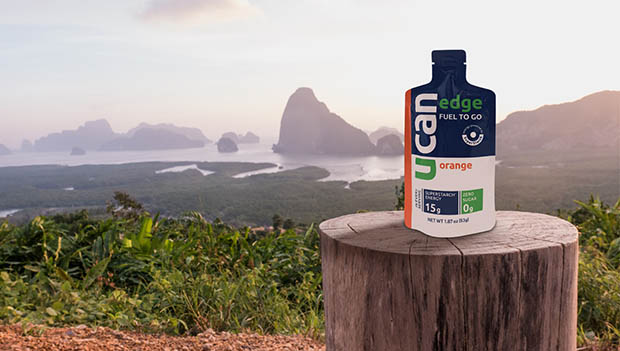
As an endurance athlete, there's no shortage of gels, bars, chews and drinks at your fingertips. All brands promise this or that—often touting better performance and taste than their competitors—and obviously, there's a lot of marketing "fluff" to filter through to figure out if a product is right for you.
Over the years, endurance athletes have essentially been guinea pigs for a number of companies, as food scientists and nutrition experts learn more about the perfect ratios of "stuff" to boost energy and performance to keep us swimming, cycling and running further, longer and faster.
I have to admit, when I was contacted to try UCAN's new Edge energy gels, I was skeptical. I've put my digestive system through the wringer over the years, consuming too many gels and other sports nutrition products through countless miles of relatively hard (or hard for me) training. I've become pretty sensitive to new products, especially on longer efforts.
But I was pleasantly surprised by UCAN's latest release.
Before we get into my personal experience training with UCAN Edge energy gels, let me first preface this by saying I'm no sports nutrition expert, performance coach or food scientist of any kind—these are my impressions as an avid mid-pack swimmer, cyclist and runner who has had lots of real-world experience of living by the gel, dying by the gel.
What Is It?
If you've been around the endurance space for some time, you've probably heard of UCAN before. But for those of you who haven't, the company got started after a couple of parents were looking for a carbohydrate alternative to help manage their son's blood sugar levels. They discovered, through a team of Scottish carb researchers, that if a certain cooking process was applied to a specific type of non-GMO cornstarch, it delivered a steady release of glucose over several hours, and thus SuperStarch was born. Since then, the likes of Olympian Meb Keflezighi and IRONMAN champion Tim O'Donnell have used UCAN products to help fuel themselves to the top of their sports.
While UCAN has had other products on the market for years, Edge gel is the latest offering that features its proprietary SuperStarch formula. It has zero sugar (the only one on the market), and it's GMO free, gluten free, vegan friendly and keto friendly. One pouch has 70 calories per serving, 19 grams of carbohydrate, 55 mg of sodium, 180 mg of Vitamin C and 10 mg of Calcium—basically everything you're looking for in a simple, straightforward gel housed in a single-serving packet.
Taste
No matter how good a gel might be for your performance, if it doesn't taste good, it's really going to be hard to swallow when you're deep into a race or training effort.
Right now, UCAN Edge is only available in one flavor, "Orange," and despite wanting to try other flavors, I love that it's not something fancy like orange blossom or passionfruit orange. It's one of the most interesting gels I've tasted—not too sweet, and it has a tart kick that's very citrus-like. I found myself not hesitating to reach for a pack even when it was hot out or during particularly hard workouts (when other gels can sound totally unappealing).
Consistency
UCAN Edge strikes a nice balance between the way-too-watery isotonic gels and gum-like concentrated gels endurance athletes love to hate. It has a nice consistency and goes down easy without leaving a lasting aftertaste or coating in your mouth. The packaging doesn't explicitly state it, but be sure to shake the pack before opening to make sure the consistency is, well, consistent.
Edge has an almost fibrous mouth feel—slightly grainy like the SuperStartch isn't completely dissolved. I didn't mind, and it certainly wasn't a game changer, just noticeable compared to other gels I've tasted. If anything, I associated this with a more "natural" taste that isn't over-processed. I also washed down each pack with water, but that was more due to habit than necessity.
Performance
Over years of endurance training, my digestive tract has become frustratingly sensitive to gels and other "sports nutrition" products. I've had more gels than I can count, and while they're great for an immediate kick, if I have more than a couple in a session, I start getting the "gel gut" many of us are familiar with us.
To make sure I was getting the most out of UCAN Edge, I followed the directions on the back of the packaging and consumed one 30 to 45 minutes before my rides and runs and once an hour if needed. Unlike other caffeine- and sugar-packed gels, I didn't initially feel a noticeable boost in energy—which is what the SuperStarch formula is known for. Of course, every workout is different, and energy levels are influenced by a wide range of factors (sleep, stress, diet, etc.), but Edge seemed to provide a reliable, sustainable level of energy through both shorter, more intense efforts and longer, more mellow rides and runs. I also never experienced any digestive discomfort before, during or after a workout where I only used Edge as the main fuel source.
I have no way to monitor this personally, but studies have shown that UCAN (specifically the SuperStarch formula) increases fat oxidation compared to other sports nutrition products. Given the slow burn and the lack of a spike in energy I experienced, I'd wager this is true over longer training periods. If you're used to other gels, I'd suggest experimenting with UCAN during training efforts to give your body time to adjust to using more fat and less carbohydrates for fuel before jumping into a race with UCAN as a main fuel source.
Where to Buy
You can find Edge Energy on UCAN's website, or you can use its store locator to find a local running/cycling shop that sells UCAN products near you. At the time of publishing, a 12-pack box is $29.95 for a one-time purchase, and if you set up a subscription, shipping is free and you save an additional 10%.
UCAN also offers a complete line of sports nutrition products, including energy bars, granolas and almond butters, hydration solutions, protein and more.
READ THIS NEXT: Understanding GI Distress in Triathlons—and How to Prevent It








Discuss This Article